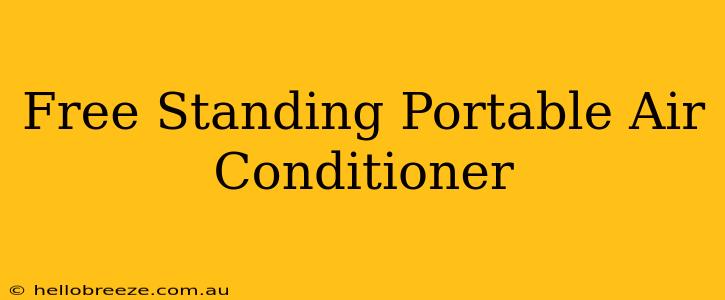Summer heat got you down? A free standing portable air conditioner might be your perfect solution. These convenient units offer a refreshing escape from sweltering temperatures without the hassle of complex installation. But with so many options on the market, how do you choose the right one for your needs? This comprehensive guide will help you navigate the world of portable AC units and find the perfect fit for your home or office.
Understanding Free Standing Portable Air Conditioners
Unlike window units or central AC systems, free standing portable air conditioners are designed for ease of mobility. They're self-contained units that typically include:
- Cooling Unit: The core component responsible for reducing the air temperature.
- Exhaust Hose: Vent warm air outside, usually through a window or door.
- Wheels and Handles: For easy movement from room to room.
- Control Panel: Allows you to adjust temperature settings, fan speed, and other functions.
- Water Reservoir/Drainage System: Collects condensation produced during the cooling process.
This all-in-one design eliminates the need for professional installation, making them a popular choice for renters or homeowners who want a temporary cooling solution.
Key Features to Consider When Buying a Free Standing Portable Air Conditioner
Several factors influence the performance and suitability of a portable air conditioner:
1. BTU Rating (British Thermal Units):
The BTU rating indicates the cooling capacity of the unit. Higher BTU ratings mean more powerful cooling, suitable for larger rooms. Consider the square footage of the room you intend to cool when selecting a BTU rating. A poorly matched BTU rating will result in either inadequate cooling or wasted energy.
2. Energy Efficiency (EER or SEER):
Energy efficiency is crucial, both for your wallet and the environment. Look for units with high Energy Efficiency Ratios (EER) or Seasonal Energy Efficiency Ratios (SEER). Higher EER/SEER ratings mean lower energy consumption.
3. Noise Level:
Portable AC units can be noisy. Check the decibel rating (dB) before purchasing. Lower decibel ratings indicate quieter operation.
4. Dehumidification Features:
Many portable AC units offer dehumidification, a useful feature in humid climates. This function can help improve air quality and comfort.
5. Controls and Features:
Explore different control options – some offer basic on/off switches, while others have digital displays, programmable timers, and remote controls. Consider the features that are most important to your convenience.
6. Size and Portability:
Ensure the unit's dimensions and weight are manageable for your space and ability to move it. Check for features like smooth-rolling wheels and integrated handles for easier portability.
Choosing the Right Free Standing Portable Air Conditioner for Your Needs
The best portable air conditioner for you depends on several factors, including:
- Room Size: A larger room requires a higher BTU rating.
- Climate: A humid climate may benefit from a unit with strong dehumidification capabilities.
- Budget: Prices vary widely based on features and BTU capacity.
- Personal Preferences: Consider features like noise level, control options, and portability.
Maintaining Your Free Standing Portable Air Conditioner
Regular maintenance will extend the lifespan and efficiency of your portable AC unit:
- Clean the filters regularly: Clogged filters restrict airflow and reduce efficiency.
- Empty the water reservoir: Failing to do so can lead to spills and potential damage.
- Clean the condenser coils: Dust buildup on the coils reduces cooling efficiency.
Investing in a quality free standing portable air conditioner can significantly improve your comfort during hot summer months. By carefully considering the features outlined above, you can choose the perfect unit to keep cool and comfortable all season long. Happy cooling!

